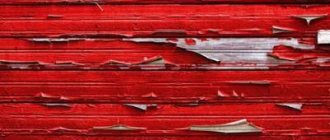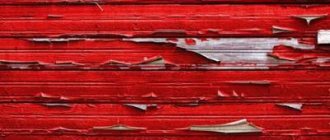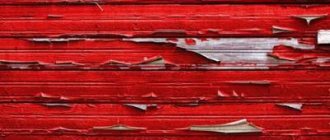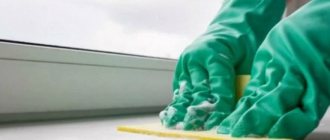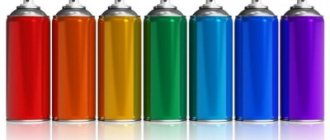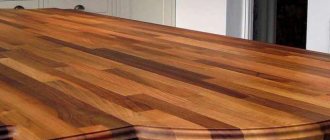Wooden doors bring a special charm to the interior, but only if they look decent and the paint is applied carefully.
Cracks in the paintwork, faded shade and peeling paint on the doors can ruin the entire impression of the room.
There is a need to remove old paint. For this purpose, proven chemical, thermal and mechanical methods are used.
We'll tell you more about how to remove old paint from a wooden door in this article.
Is it necessary to remove old cracked paint from a product?
Treating the wood before painting further facilitates the effective application of the new paint coating. Inspecting the wood surface will help you determine how to treat and remove the old paint, and whether it needs to be done at all. Removal of the coating is necessary if:
- it cracked, swelling appeared
- Several layers have already been applied to the surface, causing its coating to become uneven and lumpy
- the previous version was of a different quality/texture or color. This may negatively affect the final result of painting, or the latter will lie unevenly, lag, etc.
You need to prepare for the fact that removing paint from a surface is a labor-intensive process that will require a lot of effort and time. If you do not know how to remove paint from wood or do not want to bother yourself with such work, contact qualified craftsmen.
Additional Information:
One of the easiest ways to get rid of an old layer of paint or varnish is a chemical method. The essence of this method is to apply a certain solution to the surface of the furniture, which will soften the old layer of paint, and after that it can be easily removed. The choice of solvent directly depends on the material with which the furniture is covered.
The mechanical method of removing old paint is justified if the paint layer is already very old and the paint easily peels off in layers from the surface. How to remove old oil paint from walls by hand? It is also a good idea to mechanically remove old paint from flat or small surfaces, such as window frames.
Using Dilunette, a jelly-like alkaline cleaner, you can scrape the paint layer clean off. It is better to apply the jelly to the surface of the chair with a brush with nylon bristles. Due to its consistency, the product adheres well and is retained even on steep planes.
As soon as the beige color of the product turns brown (depending on the thickness of the coating, this should take from 15 minutes to 12 hours), remove the dissolved paint with a scraper and spatula.
3. Direct a stream of hot air onto the surface to soften the paint. When the paint starts to bubble, remove it with a putty knife. To remove paint from recesses, use a triangular spatula or a razor rather than a flat one.
Try not to damage the wood, especially if you plan to varnish it later.
A hair dryer heats the air to 650oC and regulates the temperature. It does not have an open flame, which helps prevent the wood from being scorched. You can use a hairdryer both outdoors and indoors. The main thing is that it is well ventilated.
An effective method for smooth flat surfaces and for textured products, such as textured furniture.
But when the surface is wooden, then we can only recommend a chemical method of cleaning the surface. The thing is that wood itself is a very soft material and with intense exposure to it, defects can form, which will subsequently affect the aesthetic appearance of a wooden wall or door.
If you apply fresh paint over the old one, the furniture will not look better: the fresh coat of paint will be uneven and will soon peel off
Therefore, it is very important to properly prepare the furniture surface for painting. First of all, you need to carefully remove the old paint without damaging the surface of the wood.
Additional tips and tricks
When carrying out work on updating the paint on the wooden floor in the apartment, it is also recommended to take into account additional tips.
Selecting the optimal cleaning method depends on a combination of factors, including layer thickness, type of paint, current condition of the surface and the allocated budget for repairs. In situations where no method has helped remove the paint, you will need to completely replace the wood. This is due to the fact that the paint has already been absorbed into the surface and cannot be removed. This process will interfere with the adhesion of the new layer to the floor, so it is easier to perform a complex installation.
Types of washes
Paint is best removed with special compounds that react with it. The canvas softens, but neither universal nor specialized removers have any effect on the structure of the wood. The first products are suitable for removing various materials based on water or solvent. Special removers are available for cleaning certain varnishes and paints. They contain substances that affect the structure of a particular coating.
Powder
Paint and varnish removers are available in different forms. The consistency of the washes is liquid, which cleans surfaces decorated with carvings well. Varnishes cope with several layers of cracked old material. Dry wash is more effective, suitable for cleaning large areas, and applies evenly when water is added.
Paste
In order not to dilute the powder with liquid to obtain the desired consistency, you can purchase a ready-made product in the form of a paste at a hardware store. The work is carried out in stages:
- The composition is applied to the surface with a regular brush.
- The door is wrapped in plastic wrap for 3 or 4 hours.
- The paint is removed with a sharpened spatula without pressing the tool.
- Water is combined with vinegar in a ratio of 5 to 1 and the remaining paste is removed.
The entire coating is not always removed at one time; in this case, the surface is sanded with sandpaper.
Using a remover, remove 8–10 layers of varnish or paint. You can make your own paste from caustic soda. The product is dissolved in water, oatmeal is added.
Gel
To remove paint, it is convenient to apply products with a jelly-like consistency to horizontal and vertical surfaces of different thicknesses. One of the inexpensive but effective Prestige gels does not require mixing or shaking before use. The remover is applied to the paint in a layer of 3 mm. After 3–5 minutes, the material is cleaned off with a spatula.
Syntilor Light gel removes polyurethane, acrylic, epoxy coatings, acts very quickly, and washes off enamel and water-based paint from wooden surfaces. The product penetrates into the deep layers of varnish, softening them. There are no acids in the gel; the composition is applied using a roller or brush in a layer of 1 mm.
Special fluids
To remove paint on wooden surfaces that have many small parts or carvings, it is recommended to use liquid reagents instead of paste or powder removers.
Before applying the composition to the door, wipe off dust and dirt, cover the metal parts and begin cleaning:
- The reagent is collected onto a brush and distributed over the surface.
- The canvas is wrapped in polyethylene and left for the time specified in the instructions for the liquid.
- Pry off the paint with a spatula and carefully remove it.
When using washes, safety precautions cannot be ignored, since they contain reactive substances. After removing the old coating, the wood is wiped with water and vinegar, primed, varnished, and painted.
Wax pencils and polish for bare wood and MDF
Scratches and other damage can be repaired on wooden surfaces with wax and polish. Polishes are substances that can add shine to the surface being treated. They are presented as paste-like mixtures or emulsions that have a long shelf life.
To remove a scratch in wood, sand the damaged area with a fine abrasive, then apply soft polishing wax and rub with a cloth. A soft wax pencil is used to treat deep scratches. Pencils have a wide color palette, which allows you to choose the desired tone. After repairing the damage, remove any remaining wax with a dry cloth. The surface is coated with varnish or paint to match the door.
When working with MDF profiles, wax pencils are simply irreplaceable when you need to cover the gap at the joints of the profile.
Pros of using wood correctors:
- Operational restoration
- Variety of color palette
- Versatility
- Durability due to increased material adhesion and water resistance.
Heat treatment
To clean wood, you can heat it. As a result, the paint material will adhere to the base much worse. Cracks will appear on the coating, and it can be removed using a special tool (spatula, chisel).
When carrying out heat treatment, there are several important points to consider.
- If the coating begins to char instead of peeling off, the cleaning method will have to be changed. In this case, you can use chemicals.
- Goggles and protective gloves must be used. Also, thorough ventilation is required during and after work. When varnish heats up, it can release substances that are hazardous to human health. It is also worth considering that pieces of paint and varnish material may bounce off the base. You should also remember about fire safety.
The work may require special equipment.
Construction hairdryer. Such a device can heat surfaces much more than a conventional household appliance.
Gas or gasoline burner. The price for such devices is quite reasonable
However, it should be borne in mind that you need to work with the burner as carefully as possible, otherwise you can be seriously injured.
Heat treatment has one important advantage - the work is carried out very quickly. However, the varnished base should not be allowed to overheat, otherwise a fire may occur.
You should work using both hands. One needs to hold the device, the second - a spatula, with which you will remove the paintwork.
See below for a master class on removing varnish from a wooden surface.
Heat treatment
The essence of this process is to heat the wooden surface, due to which the varnish adheres less firmly to the surface. In other words, the varnish begins to crack, after which it can be pryed off with a tool (a chisel or spatula will do) and slowly removed.
Please pay attention to the following nuances:
- During work, you need to use protective equipment (gloves and goggles), and also ventilate the room. The fact is that when heated, the varnish releases toxic substances, and when the material is mechanically separated, pieces can bounce off of it. Also, do not forget about fire safety.
- If the varnish is heated up, but does not peel off, but becomes charred, you need to change the cleaning method and you cannot do without chemicals.
Required tools:
Gasoline or gas burner. Such devices are quite inexpensive
However, the burner must be used with extreme caution, as the work will be carried out with an open flame. Care must be taken when working with the burner
Construction hairdryer. The device is similar to a household hair dryer, but has significantly greater temperature capabilities, heating up to 600 degrees.
Note! A standard household hair dryer is not suitable for removing nail polish. The main advantage of the thermal method is its high speed of operation.
However, we must not forget about the danger of overheating the varnished surface, since in this case it may catch fire.
The main advantage of the thermal method is its high speed. However, we must not forget about the danger of overheating the varnished surface, since in this case it may catch fire.
The work is done with both hands: one holds the hairdryer, which heats the surface, and the second holds a spatula for removing nail polish.
How to remove old stubborn paint from a wooden surface?
To properly paint old wooden doors, first remove the worn-out coating. Clean carefully so as not to disturb the surface of the door leaf. Particular care will be required if you need to repaint a veneered wooden door. The veneer is very thin and is susceptible to mechanical stress. There are four common methods for removing old paint from wooden surfaces.
Mechanical
The most labor-intensive and aggressive mechanical method is used when other methods of removing paint from a wooden surface have not brought a positive result. Veneered doors are not subjected to such cleaning. Mechanically, durable nitro paints and alkyd enamels are usually removed. Peeled areas are cleaned with a scraper or spatula. The stubborn paint is removed with a grinder, grinder or drill with grinding attachments. It is difficult to rub with sandpaper. It is usually used if there is no power tool.
Sandblasting Applications
The mechanical cleaning method includes the use of sandblasting. Air supplied under high pressure from the compressor mixes with dry sand particles and breaks the old paint with a strong jet pressure.
Sandblasting can easily remove varnish or enamel from a wooden door in a few minutes, but it is important not to overdo it. The impact of grains of sand crushes the wood along with the paint.
If you stay in one place for a long time, the surface will be damaged. To remove a thin layer of paint, use a fine abrasive: river sand or soda.
Heat treatment
The panel and panel doors are subjected to heat treatment. For a safe method of removing paint, use a heat gun or a hair dryer powered by electricity. When heated, the old coating acquires a soft structure that can be easily scraped off with a scraper
Professionals use gas torches, but work with such tools carefully. An open source of fire along with paint can burn wood
Chemical method
To remove paint from doors chemically, use solutions that soften most types of enamels and varnishes. The work is performed in a well-ventilated area using personal protective equipment. The method is suitable for veneered door panels, but first you need to check the instructions to see if the solution is safe for veneer.
To remove old paint from a wooden door, just lubricate it with a chemical. After 5–10 minutes, the coating will rise in bubbles that can be easily removed with a scraper.
Should I delete it?
When choosing a method for removing old paint, the question may arise: does it need to be removed at all? The answer to this question and the choice of coating removal method depend on the following factors:
- door surface type;
- condition of the coating;
- type of paint used;
- adhesion strength of the coating to wood;
- thickness and number of layers.
The most difficult thing will be to remove the layer of paint coating, which has good adhesion to the material, and the door itself has a complex surface topography and a lot of decorative elements.
depending on the condition of the coating, you can get by with sanding
Old layers of paint that, due to atmospheric influences and time, have significant defects (chips, cracks, swelling) will have to be removed. It is also necessary to remove too thick a layer of paintwork that has hardened streaks and other results of careless handling of the door in the past.
It happens that new door paint is incompatible with the old one. This is also a reason to completely remove paint from wooden doors.
The need to remove water-based paint
Interior decoration is carried out using various decorative materials. Coloring is used very often. To do this, dyes on different bases are used. The widespread use of water-based paint is due to its following positive features:
- large selection of colors;
- the created coating does not require special care, and if necessary, contamination can be easily washed with water;
- the material emits virtually no odor;
- painting work does not require special knowledge and skills.
The disadvantages include the fact that washing off spilled water-based emulsion is a problematic process.
In the case when the paint adheres well to the entire surface planned for repainting, it does not need to be torn off. A new layer is simply applied on top of the wall, having previously cleaned it of various contaminants and treated it with a primer. The latter forms a coating with increased adhesion properties.
To treat surfaces painted with water-based emulsion, acrylic-based primers are used.
- if there are exfoliated areas, swellings;
- when repainting is done with dyes of lighter colors;
- in case of incompatibility of finishing materials: old and new;
- during major repair work.
Old peeling coating
The appropriate removal method is chosen taking into account the surfaces for which the old paint mixture was intended: glass, concrete, wood.
Consumables
Rags for removing dust, polyethylene to protect furniture and other objects, tape - it’s difficult to immediately say why it might be needed, but it’s a fact that it’s useful for something.
There are various removers available for old paint. Try to determine the type of paint and varnish material and select the appropriate chemistry.
Bringing an old door back to life
The easiest option, but most expensive, would be to replace the old shabby wooden door leaf with a new one made of MDF, hollow inside. A thrifty owner will not throw away the old door, but will begin to restore it if:
- it is made of oak or other dense material that will last for several decades;
- has dimensions that differ from those accepted by the standard, especially in Stalin buildings with high ceilings. Making such a canvas to order will cost the owner a pretty penny;
- has an unusual decoration with carvings;
- The owners are creative people who can turn an ordinary wooden door into an art object.
Removing paint from a door
The procedure for bringing an old wooden product into proper form is conventionally divided into several stages:
- removing the old layer;
- repairing the door, preparing its leaf for new painting;
- fresh paint.
In order for the product to get a new life, to serve its owners for the intended time, and to avoid swelling and peeling, it is necessary to remove the old paint from the doors. Among the various methods, there are several main ones:
- thermal;
- mechanical;
- chemical.
Heat treatment
Heat treatment is carried out by directing hot air at the door. Such purification occurs when using gas burners and construction hair dryers. The advantage of this method of removing old paint from a wooden door is the absence of dust, but the disadvantage is the high probability of fire on the surface being cleaned. Such procedures are carried out outdoors, with the use of personal protective equipment (respirators, masks), and have a tank of water on hand in order to eliminate the possible occurrence of a fire in the bud. It is used in cases where there are several layers of coating on a wooden surface. Under the influence of hot air, the previously applied coating swells; it is scraped off with a spatula.
Mechanical cleaning
You can remove paint from the door using scrapers, spatulas, and metal brushes. The door is removed from its hinges, laid in a horizontal position, and the paint is removed using improvised materials and a sanding machine. The method is not effective due to dust and possible damage to the wooden surface.
Chemical cleaning
Characterized by obtaining a positive result, it is in greatest demand due to the speed of action of stripping reagents, which, when applied to an old paint layer, soften it, thereby facilitating the removal of old paint.
Attention!
Work is carried out in the open air or with a constant supply of fresh air due to the specific smell of cleaning agents.
Tools for work
The following tools are used to heat the painted surface:
- heat gun (melts the paint - easier to remove with a knife or brush);
- hair dryer (construction) - used for wood, can be used indoors, temperature is adjustable;
- gas burner;
- blowtorch;
- iron with foil.
The mechanical cleaning method, in addition to sandpaper, spatula, knife, and metal brush, involves the use of the following power tools:
- grinder equipped with a grinding attachment;
- Sander;
- drill with a brush for metal.
For chemical cleaning, you will need a spatula.
Having figured out how to effectively remove paint from a wooden door, you can begin the processing process. These methods will help you save on purchasing a new structure and improve the old one.
How to paint a wooden door correctly?
When deciding to paint wooden doors with your own hands, you must not forget about the frame. A structure that has different frame and sash colors will look strange. There are two ways to prepare a wooden door for painting:
- The door leaf is removed from its hinges and laid horizontally on a flat table or stools. Cleaning and painting of the sash and frame are carried out separately.
- The door leaf remains hanging on its hinges. After cleaning the sash and frame, it is fixed with wedges in the open state for the duration of painting.
Of the two options, it is better to paint a wooden door at home with the leaf removed. Drips will not appear on a horizontally laid canvas, and it is much easier to clean the old coating. If the fittings are non-removable, use the second option.
Dyeing in the usual way
The usual method of painting means painting a wooden door white or giving it any other shade without the effect of artificial aging. Opaque enamel is used for work. The roller and paint brush are pre-prepared by removing loose bristles with villi.
The painting process in the usual way depends on the design of the door block:
The panel wooden door is painted with a roller. First, paint is applied to the ends of the sash. Next, roll the roller from the left corner of the upper part of the canvas to the right, and so on across the entire surface. After the first layer has dried, the sash is painted in the longitudinal direction. The second layer is allowed to dry. In the finale, the coloring of the ends and the canvas is repeated from the top corner from left to right.
A wooden paneled door is painted with a paint brush. First, cover the ends of the sash, figured protrusions and depressions. Further painting of the surface of the canvas occurs according to the scheme used for the panel door.
If the door block needs to be made with an antique effect, use a concentrated stain without coloring enzymes. During impregnation, the solution burns the wood, giving it a gray-brown color. Shades are changed by adjusting the concentration of stain.
When painting with water stain, the door leaf is first moistened. You don't even have to remove the sash. To avoid drips, start painting from the bottom up. The first layer of stain goes along the fibers, the second – across, the third – again along the fibers.
Painting with a water-based stain slightly lifts the wood grain. After the third layer has dried, the surface of the sash is sanded, dust is removed and painted again once. Alcohol stain does not lift fibers. There is no need to sand the blade.
Wood imitation
To beautifully paint a wooden or MDF door, use two opaque enamels on the same base, but with a light and dark shade. The best combination is yellow, beige or gray with brown. First, the door leaf is painted in a light tone. After drying, the product is treated with soap. A layer of brown paint is applied on top. Finally, the soap is washed off with water until the canvas takes on an antique look.
To decorate a wooden or veneered door, brush the surface. After the appearance of soft veneer fibers, an imitation of wood texture appears. One or two coats of paint are applied to the doors, and after drying they are sanded.
Ways to remove old paint
There are several ways to remove old paint from a wood surface:
- thermal;
- chemical;
- mechanical;
- sandblasting.
When using the thermal method, it is important to ensure that there is no fire.
Thermal
There are 2 types of thermal treatment of old wood surfaces:
- internal (work is carried out using a construction hair dryer: hot air is blown onto the paint and varnish material, it dries and is easily peeled off with a spatula);
- external (the paint is burned with a gas torch and then peeled off).
Chemical
The chemical method must be used with extreme caution, since any chemicals can cause a number of diseases due to their improper use. Hardware and construction stores sell special solvents and removers on the shelves of their stores, with which you can remove the old layer in a matter of minutes
When purchasing such products, you must pay attention to the country of origin. Of course, imported goods will be more effective and reliable means
It is not recommended to purchase Russian goods, since their quality is slightly inferior to foreign ones.
The process of removing the old coating is carried out in stages as follows: first you need to open the windows and doors so that fresh air can enter the room; then they cover the floor (especially if it is wooden) so that the softened paint does not have to be peeled off after washing; after which the layers are removed with a roller or brush.
If you applied a solvent, you need to wait until it acts and softens the paint material. This will take approximately half an hour or 50 minutes. The procedure is repeated if there are still many layers left on the wood.
Removing old paint from wood can be done using folk remedies - then ordinary soda with water and ground oatmeal is best suited for this task. The resulting paste forms bubbles on the surface, after which it can be scraped off
It is also important not to forget about degreasing the surface and ventilating the room after using such a seemingly harmless drug.
Mechanical
The mechanical method involves manual processing of wooden surfaces. This is a rather labor-intensive process that takes a long time. In addition, a significant disadvantage of mechanical removal of enamel is that large scratches and other damage may remain on the wood, which will have to be puttied in the future.
How to remove old paint from a wooden surface using the manual method more quickly and just as effectively. In this case, a grinder and a drill can significantly speed up the processes and have the same final effect, but this requires special attachments: emery flap and metal. The first one easily peels off the enamel if the layers are not large, and the second one is designed to clean the surface in advanced cases.
Contraindications to the use of the mechanical method:
- the presence of unevenness (after removing the previous layer, existing cracks will not only remain, but will also increase in size);
- using a grinder or drill to clean wood materials in the area near glass or baseboards;
- a huge amount of dust if you work in an apartment or inside a house.
Application of sandblasting
From the name of this method it is absolutely clear what will be discussed. So, in order to easily remove the unnecessary layer and not damage the material, a stream of water mixed with fine sand is used. Such materials in tandem quickly remove paint and do not leave cracks, scratches or dents. The disadvantage of sandblasting is that to use this method it is necessary to have, firstly, a set of necessary equipment and tools, and, secondly, highly qualified experienced staff who can carry out the cleaning technology step by step and correctly.
Painting a metal door
Entrance doors have a large surface area, so they are preferably painted using a spray gun or a roller. Painting begins from the top, moving down and trying not to go into the painted layers. After 15-20 minutes, light and unpainted areas are re-painted. If drips appear during painting and have dried, they are protected with sandpaper after the surface has completely dried and the entire surface is repainted. The loops are also painted in the desired color. Since the paint has a strong chemical smell that does not disappear for a long time, painting a metal product is done on the street or in a utility room with open doors and windows.
Attention!
Do not apply painting in rainy weather or frost. With high humidity, there is no strong adhesion of the paint to the product, and in the cold the paint thickens and does not adhere well to the surface.
To avoid unpleasant surprises, experts advise using new paint of the same brand, even if the old coating is completely removed. In this case, the owners will avoid possible problems in the form of small blisters of paint in different places. Then the updated product will not stand out as an unsightly stain against the background of a fresh renovation.
';document.body.appendChild(d);document.pnctLoadStarted=(new%20Date()).getTime();document.pnctCnclLoad=function(){document.pnctLoadStarted=0;pl=document.getElementById('pnctPreloader' );if(pl)pl.parentNode.removeChild(pl)};document.getElementById('pnctCancelBtn').addEventListener('click',function(e){e.preventDefault();document.pnctCnclLoad()}); setTimeout(function(){var%20st=document.pnctLoadStarted;if(st>0&&((new%20Date()).getTime()-st>=14000)){document.pnctCnclLoad();alert('%3C %3F%3DYii%3A%3At%28%22uniprogy%22%2C+%22Unfortunately%2C+the+image+search+is+not+available.%22%29%3F%3E')}},15000);var %20e=document.createElement('script');e.setAttribute('type','text/javascript');e.setAttribute('charset','UTF-8′);e.setAttribute('src', '//postila.ru/post.js?ver=1&m=b&rnd='+Math.random()*99999999);document.body.appendChild(e)})());">
How to remove paint using heat and abrasives?
Before repainting your piece, learn how to remove paint from wood using heat. This method is simpler than the previous one, but more dangerous, as it can cause a fire in the paintwork. The method is based on the fact that when exposed to temperature, the paint begins to decompose and release gas.
It penetrates and accumulates under the coating, causing the paint to bubble and completely separate from the wood base.
To thermally remove old paint from a wooden surface, take a hairdryer or iron that is used in construction. How to clean old water-based paint from a wall? A hair dryer works like a regular hair dryer, but has very high air heating temperatures.
In the second case: the foil is applied to the surface, heated from above with an iron, and then removed along with a layer of unnecessary paint.
The easiest way to remove old cracked paint is mechanically using:
- grinders or drills with grinding pads
- sandpaper of varying degrees of hardness (according to the size of the abrasive elements)
This creates a lot of dust, so make sure you have protective breathing masks and a gown to safely remove old paint from woodwork.
Stages of work
Before removing paintwork using remover:
- The surface is wiped from dust.
- Cover the painted wood evenly with a brush, without going over the same area twice.
- The surface covered with the wash is left for the time indicated on the label, covered with film to obtain a better effect.
- Soon the reagent becomes brown or brown in color, the paint rises, it is removed with a spatula and disposed of.
- If the result is unsatisfactory, the procedure is repeated.
- The cleaned surface is washed with an aqueous solution of vinegar, the door is wiped dry, and left for final drying in a draft.
- After drying the product, they begin to putty, seal small cracks and chips.
- Use fine sandpaper to smooth the surfaces. If you have a grinding machine, this procedure is easier. Level and polish the surface, making movements in one direction to avoid roughness.
- Use a dry rag to remove dust and putty residues.
- The door is ready for painting.
How to varnish a wooden door?
Opaque enamels completely hide the color and texture of wood. To preserve the natural texture, you can paint the door with varnish on an alkyd, acrylic or other base.
A transparent coating is optimal for a new canvas. Stain will help hide defects on old wood. After saturating the surface, apply two layers of transparent varnish in different directions. Drying takes longer than the enamel requires. Moreover, each layer must dry separately.
Using stain, you can paint wooden doors in wenge color, and top them with varnish. Sometimes they practice the use of roasting. A gas burner will help you achieve the wenge color. The wood is burned with an open flame to a dark brown hue. After sanding, even a pine board cannot be distinguished from wenge by its texture. The finished canvas is treated with a protective impregnation, and after drying it is coated with a transparent varnish.
Painting a wooden door with any paint and varnish material is available at home. You just need to strictly follow the technology.
Simultaneous use of three technologies
You can remove paint from a door decorated with small fragments or from another complex surface as follows:
- scrape off the swollen areas of the coating with a scraper;
- “walk” along the door with a drill with an attachment, not completely removing the coloring composition so as not to touch the wood;
- warm up square by square, simultaneously applying remover to the hot surface;
- wipe off dissolved material residues with a worn cloth;
- wipe with a cloth soaked in solvent;
- Sand the door with fine-grain sandpaper.
Delicate application of each method in the specified sequence will ensure gentle, non-traumatic removal of all layers of old paint to the tree.
When planning to paint structures made of natural wood, you should not neglect priming the surface. It not only provides reliable protection of natural material from dampness, mold and pests, but also facilitates the removal of outdated coatings for possible restoration in the future.
Features of paintwork
Before cleaning the door leaf, you need to determine what composition was previously applied to the surface and how many layers are present. Paints and varnishes contain chemicals. If the materials are incompatible, the new coating will be uneven, smudges and chips will appear. Having clarified all the points, you can choose the right reagent that will easily remove the old paint.
There are several methods for removing coatings; sometimes you have to combine them with each other. After removing the varnish, you need to go over the surface with sandpaper and cover up the cracks.
